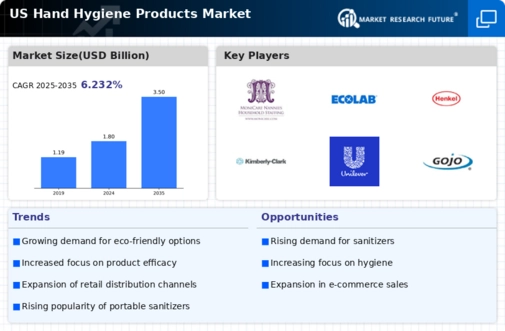The hand hygiene-products market in the US is characterized by a competitive landscape that is both dynamic and multifaceted. Key growth drivers include heightened consumer awareness regarding health and hygiene, alongside an increasing demand for effective sanitization solutions across various sectors. Major players such as Procter & Gamble (US), GOJO Industries (US), and Reckitt Benckiser (GB) are strategically positioned to leverage innovation and sustainability in their product offerings. Procter & Gamble (US) focuses on expanding its portfolio of eco-friendly products, while GOJO Industries (US) emphasizes its leadership in the professional hygiene segment, particularly with its Purell brand. Reckitt Benckiser (GB) is enhancing its digital presence to better engage consumers, indicating a collective shift towards integrating technology into marketing and distribution strategies.
In terms of business tactics, companies are increasingly localizing manufacturing to mitigate supply chain disruptions and optimize logistics. The market structure appears moderately fragmented, with several key players holding substantial market shares, yet numerous smaller entities also contributing to the competitive dynamics. This fragmentation allows for diverse product offerings and innovation, as companies strive to differentiate themselves in a crowded marketplace.
In October 2025, Procter & Gamble (US) announced a partnership with a leading tech firm to develop a smart hand hygiene dispenser that tracks usage and provides real-time feedback to users. This strategic move not only enhances user engagement but also aligns with the growing trend of integrating technology into everyday hygiene practices. Such innovations may position Procter & Gamble (US) as a frontrunner in the market, appealing to tech-savvy consumers.
In September 2025, GOJO Industries (US) launched a new line of biodegradable hand sanitizers, reinforcing its commitment to sustainability. This initiative is likely to resonate with environmentally conscious consumers and could enhance brand loyalty. By prioritizing eco-friendly solutions, GOJO Industries (US) may strengthen its competitive edge in a market increasingly driven by sustainability concerns.
In August 2025, Reckitt Benckiser (GB) unveiled a comprehensive digital marketing campaign aimed at promoting its hand hygiene products through social media platforms. This campaign appears to be a strategic response to shifting consumer behaviors, as more individuals seek information and products online. By enhancing its digital footprint, Reckitt Benckiser (GB) is likely to capture a larger share of the market, particularly among younger demographics.
As of November 2025, current competitive trends indicate a pronounced shift towards digitalization, sustainability, and the integration of artificial intelligence in product development and marketing strategies. Strategic alliances are increasingly shaping the landscape, allowing companies to pool resources and expertise. Looking ahead, competitive differentiation is expected to evolve, with a notable transition from price-based competition to a focus on innovation, technology, and supply chain reliability. This evolution suggests that companies that prioritize these aspects may secure a more sustainable competitive advantage in the future.




















Leave a Comment